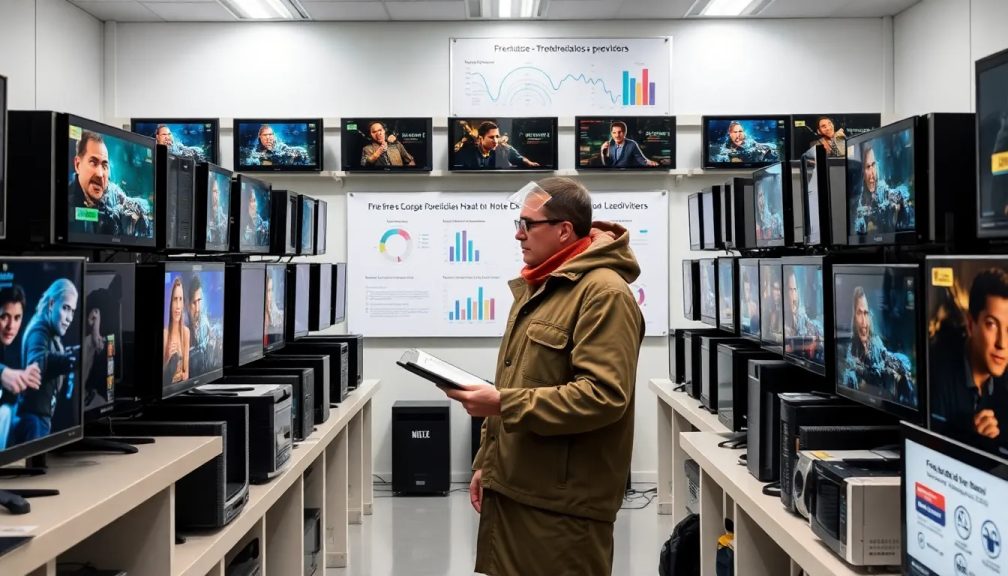Over 100 TVs Tested in 28 Months: Which Ones Failed?

When it comes to purchasing a television, many consumers focus primarily on specifications and features, often overlooking an essential aspect: longevity and reliability. While brands may promote similar products at varying price points, understanding how each model performs over time can significantly influence your decision. A recent study by RTINGS sheds light on this important concern, revealing the long-term durability of over 100 TVs tested continuously for more than two years, highlighting which models are prone to failure.
The television market has evolved drastically over the years, introducing diverse technologies and sizes. From VA panels to premium OLED displays, the choices are vast. OLEDs, renowned for their superior image quality and low latency, come with their own set of challenges, particularly the risk of burn-in. Fortunately, advancements in technology have lessened the frequency and severity of these issues. Nevertheless, it has become increasingly clear that almost all televisions face some form of malfunction over time, as demonstrated by RTINGS' extensive testing.
Testing Over 100 TVs for More Than 28 Months: What We Learned
In 2024, RTINGS published results from a rigorous evaluation of 100 televisions after over 10,000 hours of continuous use. This study highlighted that various models, whether equipped with Quantum Dot technology or Full Array Local Dimming (FALD), ultimately succumbed to issues. Notably, Edge Lit TVs were identified as the most likely to fail.
As the testing was extended beyond two years, the overarching truth emerged: every television model encountered problems, regardless of its technology or price point. Currently, with over 18,000 hours of use—equivalent to approximately 10 years of real usage—more than half of the televisions still functioning exhibited issues. This serves as a critical reminder of the inherent risks associated with television ownership.
In particular, OLED models have demonstrated significant burn-in effects; however, some, like the LG G3 and Samsung S95C, performed considerably better than others. In stark contrast, the Vizio OLED 2020 produced the worst results, showing persistent burn-in patterns that included news tickers and even silhouettes of people. Additionally, three LCD models, specifically the Insignia F50 QLED, Sony X800H, and Amazon Fire TV 4 Series, ceased functioning altogether after prolonged use.
Severe Burn-In Issues in OLEDs and LED Failures in Quantum Dots
Among the significant casualties during the testing period was the Hisense H8C, which suffered from severe backlight problems. Upon inspection, it was found that the array of 144 LEDs across 72 dimming zones had diminished to a mere 10 zones. Typically, LED televisions experience failures mainly due to backlight issues, indicating a trend where cost-cutting in production compromises the longevity of the product.
Modern televisions seldom last 10 to 20 years like their predecessors, but their prices have decreased significantly. For instance, the Amazon Fire TV Omni Series has had issues where half of the screen fails due to LED burnout. Another notable observation during these tests was the Samsung Q900TS 8K QLED, which began to exhibit signs of burn-in believed to be caused by its Quantum Dot technology.
Moreover, the TCL S546 has started to display color errors, where colors appear blotchy and inconsistent. The Vizio M6 Quantum 2021 suffered from several dead LEDs in the upper portion, rendering it incapable of displaying anything. Even the premium-priced Sony X90J experienced failure, shutting down due to a single faulty LED, illustrating that high cost does not guarantee reliability.
Understanding TV Longevity: Key Factors and Considerations
When evaluating televisions, it’s crucial to consider several factors that can affect their longevity. These include:
- Panel Technology: OLEDs tend to face burn-in issues, while LCDs may have backlight problems.
- Manufacturer Quality: Brands with a reputation for quality control often produce more reliable models.
- Usage Patterns: How a TV is used—such as brightness settings and static image display—can influence its lifespan.
- Warranty and Support: A robust warranty can provide peace of mind against potential failures.
- Reviews and Testing: Insights from third-party testing like that from RTINGS can inform better purchasing decisions.
The Evolution of Smart TVs: A Brief History
The journey of smart TVs began in the early 2000s, with the advent of internet connectivity in televisions. By the late 2010s, smart TVs had become ubiquitous, featuring integrated streaming services and apps. This evolution has drastically changed viewing habits, making it essential for consumers to keep in mind that with added technology comes the potential for increased complexity and, consequently, more points of failure.
As smart technology continues to advance, it’s vital for consumers to stay informed about which models are the most reliable over time. Understanding the common failures can help in making informed choices about future purchases. Continuous research and consumer feedback play a crucial role in guiding the industry towards improved quality.
For those interested in visualizing these findings, a detailed video discussing the performance of various TV models can be found here:
In conclusion, while the market is filled with attractive options, understanding their long-term performance and potential issues can lead to a more satisfying purchasing decision. The findings from RTINGS highlight the importance of being aware of the inherent risks involved in owning a television, regardless of its technology or price. This awareness can empower consumers to make more informed choices tailored to their viewing needs and expectations.




Leave a Reply